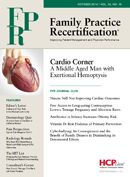Free Access to Long-acting Contraception Lowers Teenage Pregnancy & Abortion Rates
A look at whether providing free contraception impacts the pregnancy and abortion rates among teenagers.

Frank J. Domino, MD
Review
Secura, Gina, PhD, et al. “Provision of No-Cost, Long-acting Contraception in Teenage
Pregnancy.” New England Journal of Medicine 2014; 371:1316-23.
This study evaluated providing long-term reversible contraceptive methods to teens at no cost and its impact on pregnancy, birth, and induced abortion rates in girls aged 15-19.
Study Methods
This was a cohort study (Contraceptive CHOICE project) involving female teenagers aged 15-19 in the region surrounding and including St. Louis, MO. The teens were recruited by referral from their medical providers, word of mouth, and flyers. Minors aged 14-17 were enrolled with both student agreement and parents providing written consent. As part of the study minors could enroll using a “waiver of parental consent” if they did not know the whereabouts of their parents or guardians, or if they did not want their parent or guardian to be aware they were seeking contraception. There were only four minors enrolled who took this waiver.
Those enrolled were offered a variety of contraceptive options. The options offered were described in order from most to least effective as well as their potential side-effects, risks, and benefits described at no cost.
The intent of taking this approach was to determine the effect of free access to long acting, reversible contraceptives (LARC) on pregnancy outcomes, compared to national averages during the same study period. If the participant could not decide which method to use on the day of implementation, they were offered a short acting agent including oral contraceptives and depot medroxyprogesterone acetate until they decided.
Results and Outcomes
Over 1,400 teenage girls and women were enrolled in this study. Of that group 72% chose either an IUD or an implanted (LARC) method. The remaining 28% chose another method. Participants were monitored from 2008 to 2013 and rates of pregnancy, birth, and abortions were followed.
For pregnancy, the annual rate in the comparison community was 158.5 per 1000 teens vs. 34 per 1000 teens in the study, resulting in a risk reduction of 79%. For births, the community rate was 94 per 1000 teens vs. 19.4 in the intervention group, giving a reduction of 78%. For induced abortions, the rate in the comparison community was 41.5 per 1000 vs. 9.7 per 1000 teens in the intervention group, giving a reduction of 77%.
Demographics of participants found greater than 60% were African-American, and about 45% were considered of low socioeconomic status. About 1/3 did not have any form of health insurance. The vast majority had on average 3 sexual partners in the past, with almost 50% having had at least one unintended pregnancy in the past. Almost 20% had had at least 1 abortion in the past and almost 25% had a history of an STI.
Conclusion
Making long-acting, reversible contraceptive methods available for teens that are currently or planning to be sexually active led to a large reduction in rates of pregnancy and abortion.
Discussion
This paper shines a bright light on the role access to health care in the United States can have on life-altering outcomes. It has implications that benefit the individual as well as society. And strangely, may hopefully lead to acceptance by a broad range of political opinions.
Rates of adolescent sexual activity have diminished slightly in the past 10-15 years in the United States. According to the CDC, approximately 47% of all high school students have reported having sexual intercourse in 2013, which is down from 54% in 1991 (CDC Youth Risk Behavior Surveillance System: US, 2013. MMWR; 63(4):2014). Two thirds of sexually active teen males and approximately half of teen females said they had used a condom at their last sexual interaction (CDC Youth Risk Behavior Surveillance System 2013 MMWR; 63(4): 2014).
Recent data has demonstrated use of long-acting reversible contraceptives (LARCs) including IUDs is safe for adolescents (http://www.hcplive.com/publications/family-practice-recertification/2013/October2013/IUD-Use-in-Teens-Is-it-Safe-and-Effective). Despite their safety and efficacy, utilization rates have been low. The presumption for this low uptake has been the barrier of cost, the ability to give consent without parental involvement and an assumption about IUD’s being contraindicated in teens and those in non-monogamous relationships.
The Affordable Care Act recommended making all forms of contraception freely available to women through their physician’s practice. Political groups initially fought strongly against this provision. Now, in a unique turn of events, typically conservative candidates are endorsing making contraceptives available without a prescription, but at a cost to the end user, as long as they’re not required to be covered by health insurance policies.
This initially seemed to imply greater access to contraceptive methods. Critics have countered that requiring the end user to pay all of the costs for contraception will lower the use of contraceptive methods, increase unwanted pregnancy and abortion rates, and may be discriminatory against women.
The burden of an unplanned and unwanted pregnancy is personal and societal. There are health implications for the child as well as the parent. Being able to reduce the unwanted pregnancy rate by almost 80% through an initiative eliminating barriers to contraception is truly remarkable.
Like the advent of clean water and seat belts, offering healthcare interventions at no cost that improve the lives of those at greatest risk seems to make exceptional sense. Learning to provide long acting, reversible contraceptives will serve your patients, your practice, and your community as well as the nation’s financial, mental, and physical health. Long-acting contraceptive methods should be offered to all teens now with continued STI screening and with a focus on counseling about safe sex practices and condom use.
About the Author
Frank J. Domino, MD, is Professor and Pre-Doctoral Education Director for the Department of Family Medicine and Community Health at the University of Massachusetts Medical School in Worcester, MA. Domino is Editor-in-Chief of the 5-Minute Clinical Consult series (Lippincott Williams & Wilkins).
Additionally, he is Co-Author and Editor of the Epocrates LAB database, and author and editor to the MedPearls smartphone app. He presents nationally for the American Academy of Family Medicine and serves as the Family Physician Representative to the Harvard Medical School’s Continuing Education Committee.
